More than 100,000 different kinds of flies have been discovered and named by scientists all over the world. Some common examples include house flies, horse flies, gnats, midges, and mosquitoes. All flies belong to the insect order Diptera, which means "two wings." Since nearly all other insect groups have four wings, the name accurately reflects a unique feature of this group.
In nature, flies perform a vital function as decomposers of dead organisms, manure and decaying vegetation. These organic materials serve as breeding and egg-laying sites for the adult flies, and as food for immature flies, which are usually called maggots. Flies are also an important food source for many other kinds of organisms, including birds, fish, reptiles, and even some plants like the Venus flytrap.
Unfortunately, several species of flies and gnats have adapted to living in human structures. When flies are found in human structures, they are almost always considered to be nuisance pests. Some kinds of flies are also a potential threat to human or animal health. These flies may act as carriers of disease organisms present in their breeding and egg-laying sites. These disease organisms can cause food poisoning, diarrhea, dysentery or typhoid fever.
Life history and damage
Household flies can be divided into two groups based on whether breeding and development normally occur indoors. Household infesting flies are those that breed and complete their life cycle indoors when breeding sites are available. Household invading flies are those that breed and develop outdoors but seek shelter indoors at certain times of the year. It is critical to identify which species of fly is occupying your home. Identification allows you to recognize conditions that are contributing to the infestation and pinpoint locations where management practices should be directed. We will briefly discuss some of the most common household flies.
House fly (Musca domestica)
House-infesting flies
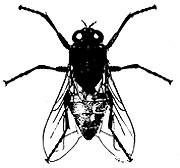 Breeding and feeding habitats
Breeding and feeding habitats
- Manure
- Dead organic matter
- Garbage
- Rotting fruits and vegetables
The house fly is the most common fly pest around homes. This fly lays eggs on wet, decaying organic matter such as moist garbage, animal manure or rotting plant debris. The eggs hatch into creamy white maggots that feed in the waste. Eventually, maggots change into an inactive pupal stage from which the adult flies later emerge. This life cycle is completed in about 14 days, depending on temperature.
Blow fly (Calliphoridae)
House-infesting flies
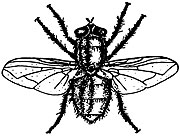 Breeding and feeding habitats
Breeding and feeding habitats
- Dead animals
- Dead organic matter
- Garbage
Several species of blow flies can be found infesting homes. These flies are shiny metallic colors of copper, green, blue or black. These flies lay their eggs on the carcasses of dead animals, decaying meat or garbage that contains meat scraps. The maggots hatch, grow to maturity by feeding on the meat, pupate, and then emerge as new adult flies. Development occurs over a 10 to 20 day period, depending on temperature.
Fruit fly (Drosophila spp.)
House-infesting flies
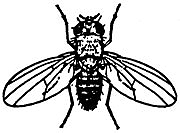 Breeding and feeding habitats
Breeding and feeding habitats
- Dead organic matter
- Garbage
- Rotting fruits and vegetables
- Drains, pipes, sewer
Fruit flies are also known as pomace flies or vinegar flies. Many of them are small (1/8 inch) and tan with red eyes. They are present outdoors during warm weather and may be pests inside during other times. They are more of an indoor nuisance during the fall when they enter houses to escape cooler outside temperatures. Fruit flies reproduce and develop on overripe and rotting fruits, vegetables, and other moist plant material. They are able to complete their life cycle in 10 to 12 days.
Phorid fly (Phoridae)
House-infesting flies
 Breeding and feeding habitats
Breeding and feeding habitats
- Dead organic matter
- Garbage
- Rotting fruits and vegetables
- Drains, pipes, sewer
- Soil with sewage
- Wet organic matter
Phorid flies are also called humpbacked flies. Adult flies are about 1/16 to 1/8 inch long, dark brown to almost black, and move in a characteristic short, nervous, jerky manner. The largest segment of the hind leg is distinctly flattened laterally. Phorid flies lay eggs on organic mater in moist conditions. The locations vary widely, but are usually associated with rotting fruit, vegetables or meat; wet organic soil; potted plants; cut flowers; garbage disposals; and floor drains. Phorid flies often become pests in commercial kitchens, hospitals and mausoleums.
Moth fly (Psychodidae)
House-infesting flies
 Breeding and feeding habitats
Breeding and feeding habitats
- Drains, pipes, sewer
- Soil with sewage
Moth flies are also known as drain, filter or sewage flies. They are tiny flies and their bodies and wings are densely covered with hair. The wings are held rooflike above the body when at rest. Indoors, moth flies breed and the larvae develop in the wet, gelatinous material that lines the inside of drainpipes. They may also breed and develop in the filter beds of sewage treatment plants. The life cycle from egg to adult can take as little as 8 days or as long as 22 days, depending on temperature. In most situations, adult flies appear suddenly in the vicinity of sinks or drains. They are commonly noticed on the bathroom mirror. In unusual situations, large numbers of moth flies can develop in the filter beds of sewage treatment plants and be blown short distances to adjacent homes. In some cases, these flies are small enough to penetrate normal window screening.
Face fly (Musca autumnalis)
House-invading flies
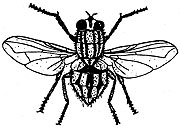 Breeding and feeding habitats
Breeding and feeding habitats
- Manure
The face fly looks much like a house fly, but differs in its biology and habits. Face flies are pests of cattle in pastures during warm months and move into the walls of buildings during fall to pass the winter. During warm days in late winter and early spring, adults may be found indoors as they come out of hiding in the attic and walls. In these situations, adult flies usually appear in the windowsill on south-facing walls. Adult face flies lay their eggs exclusively on fresh cattle manure and the maggots feed on manure during their development. It takes 12 to 16 days to complete their life cycle.
Cluster fly (Pollenia rudis)
House-invading flies
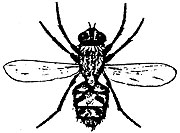 Breeding and feeding habitats
Breeding and feeding habitats
- Earthworms
Cluster flies belong to the same family as blow flies but are not metallic in color. They are dark gray, with curved, golden yellow hairs on their back behind the head. Their movements are normally sluggish and when crushed, they give off the smell of honey. Cluster flies lay their eggs in the soil outdoors. After hatching, the maggots develop as parasites inside earthworms. Their life cycle typically requires 30 to 40 days. When adult flies emerge in late summer/early fall, they may enter human structures as to pass winter. In these cases, they are usually attracted to the top floors and attic on the south- and west-facing walls. On warm days during winter/spring cluster flies may become active and invade indoor living spaces.
Flesh fly (Sarcophagidae)
House-invading flies
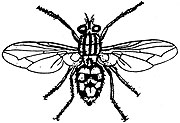 Breeding and feeding habitats
Breeding and feeding habitats
- Dead animals
- Garbage
Flesh flies are gray with black stripes running along the top surface of the body just behind the head. They are usually the first insects to arrive at a dead animal carcass and are similar to blow flies in both larval and adult biology and habits. Flesh flies are attracted to sources of decay around the home, including garbage dumpsters, compost piles and dead animal carcasses. These odors bring them into close proximity to homes where they may invade through openings such as doors and windows or cracks and crevices. They usually do not infest homes but can be major pests of industrial buildings like meat processing facilities.
Stable fly (Stomoxys calcitrans)
House-invading flies
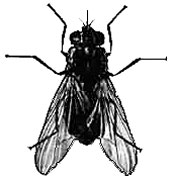 Breeding and feeding habitats
Breeding and feeding habitats
- Manure
- Decaying grass
Stable flies are also called biting house flies. They resemble house flies but they have a needlelike piercing mouthpart folded below their head. Both sexes feed on the blood of warm-blooded animals, including humans, pets and livestock. They often bite through clothing, especially on the ankles. Peak biting times are in the early morning and late afternoon. Adults lay eggs in moist decaying vegetation such as compost piles, hay bales, straw animal bedding, decaying fruits and vegetables, and grass clippings. The larvae develop over a period of 15 to 20 days.
Fungus gnat (Mycetophilidae and Sciaridae)
House-invading flies
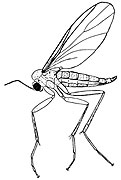 Breeding and feeding habitats
Breeding and feeding habitats
- Wet organic matter
Fungus gnats are mosquito-like in appearance but are often much smaller. They are dark gray to almost black. The larvae develop in moist organic matter that contains fungi. Little is known about the details of their life cycle. Nearly all infestations indoors are attributed to highly organic, wet soil in potted plants or atriums. Rarely, poorly ventilated attics or accumulated bird feces can also serve as breeding sites. These flies may enter from outdoor breeding sites such as wet mulch near windows and doors. They are attracted to lights and will readily enter structures when doors or windows are left open — especially at night.
Management strategies for house-infesting flies
Sanitation
Sanitation refers to activities that reduce or eliminate fly breeding and feeding habitats in and around the home. Important breeding sites for the flies mentioned in this publication are shown above. The proper management of garbage, yard and garden wastes, and dead animals reduces the availability of resources that are critical for the development of house flies, blow flies, fruit flies, flesh flies, and stable flies. Manure management reduces habitats for face flies. Cleaning drains minimizes the risk of moth flies and phorid flies, while reducing excess moisture will limit the number of potential breeding sites for gnats and phorid flies.
Household waste management is critical to sanitation. Use plastic garbage can liners inside trashcans that hold household waste. When plastic liners are full, close them tightly and transfer them directly to a large garbage can outdoors or in the garage. Make sure all garbage cans have tight-fitting lids and that they are cleaned whenever waste accumulates in the bottom or clings to the sides. Ensure that garbage is taken to the landfill or burned at the earliest possible opportunity.
Compost piles are an environmentally friendly way of recycling refuse. However, because they consist of decaying organic materials, they can serve as breeding sites for house flies, stable flies, fruit flies, blow flies and gnats. Neighbors may have legitimate complaints about nuisance flies coming from poorly maintained compost piles; however, well-managed compost piles normally generate significant amounts of heat during decay, which minimizes fly survival. If flies become a problem around your compost pile, one solution is to cover it with black plastic sheeting. The plastic serves as a barrier to flies, traps heat and reduces fly survival.
Other sanitary measures include spreading or burying animal manure and other wet waste. Removing, incinerating or burying dead animals is another important sanitary practice. It is also useful to remove overripe fruits and vegetables from the garden or incorporate them into the soil. If possible, reduce watering and organic matter in the soil of potted plants. Cleaning drains regularly or reducing moisture problems through ventilation and other means may be critical to eliminating some household fly infestations.
Management strategies for house-invading flies
Regardless of how well fly breeding sites are managed inside, flies will attempt to invade from outdoors. Factors that influence fly invasions around homes include
- Temperature
- Exterior lighting
- Filth odors.
Many kinds of fly invasions occur in response to seasonal environmental changes — especially when there is a stark contrast between outdoor and indoor temperatures. Invading flies detect cool indoor air 'leaking' from buildings during hot periods and warm indoor air 'leaking' from buildings during cold periods. They enter the openings where they detect leaks. Common entry points include open doors and windows, gaps around door and window frames, cracks, and crevices. Barriers at these entry points are necessary to minimize fly invasions from outdoors.
Exterior lighting and odors will also attract flies to areas around human structures. Many flies are attracted to lights and will be found around exterior lighting at night. The smell of food odors from improperly maintained trashcans, compost bins or pet manure will also attract flies to areas around structures. After being attracted to the exterior of the home by lighting or odors, flies are able to gain access through open doors and windows, gaps, cracks or crevices.
Barriers
Flies can squeeze through some amazingly small openings to enter buildings. Tight-fitting screening with 14 to 16 mesh (strands per inch) size are effective in excluding most flies. However, even the best screens may not keep out smaller species such as fruit flies, moth flies, phorid flies and fungus gnats. Screens should be installed on all openings, including doors, windows and vents. Frequent inspection is required to ensure that screening is maintained in good condition. In addition, as many cracks and crevices as possible on the exterior of the structure should be sealed with caulking or foam. Weatherstripping should be placed on the edges of doors and should be maintained in good condition. Kick plates below doors should also be in good repair.
Traps
Resin strips (flypaper) may be hung in infested area if there is little or no air movement. Various designs have been produced. Some involve attractive odors or diagrams of flies in feeding or mating positions. A rule-of-thumb is one 10-inch strip per 1,000 cubic feet of space. Fly strips are effective for up to about three months (or until completely covered).
Insect light traps have been designed for capturing flies inside structures. Light traps are some of the most effective methods for controlling flying insects inside structures. However, not all flies are attracted to light traps. This is another important reason to identify which type of fly has entered your home. Many flies show a mixed response to light traps because they fly during the day. However, flies that are active at night show a strong response to these traps. A variety of traps are available, but they must be used properly to be effective. See tips for using light traps for fly control.
Physical removal
The fly swatter is an effective way to control a few individual flies that have occupied the living areas of your home. Vacuum cleaners can be effective for the removal of large numbers of dead flies in the attic or other area where flies have accumulated. Removal of dead flies can be important because they can serve as a food source for other household invading insects.
Insecticides
Using insecticides should be considered as the last step in any fly management program. You should have already considered sanitation, barriers, traps and physical removal before deciding to use insecticides. In cases where insecticides are necessary, there are a variety of products to choose from, including baits, liquids, aerosols and dusts.
Ready-to-use baits can be used if they are placed outdoors in areas where flies congregate. Flies are attracted to the bait, feed on it, and die. The baits must be reapplied after rain or when the treated area has been cleaned with water. They should not be used where children or pets might come into contact with the bait.
A variety of over-the-counter products are sold for fly control in most hardware and nursery stores. These products contain pyrethrin or some kind of pyrethroid (allethrin, permethrin, resmethrin, sumithrin, deltamethrin or tetramethrin). They generally provide quick knockdown of flies and have a short-term effect. You must read and follow the label directions. It is illegal to use these products in a way that violates the instructions on the label.
Spot treatments with long-lasting sprays are useful for killing flies outside the home. These compounds are only available to licensed pest management professionals. These sprays are applied to areas where flies rest, such as outer walls (especially the south- and west-facing), under porches, and in garages, breezeways and doghouses. Liquids can also be applied with a brush around windowsills outdoors. Outdoor treatments are especially useful if applied just before cluster flies and face flies begin to seek places to pass the winter. Ensure that pets are removed from areas that are being treated and do not allow them to return until the insecticide is dry. Contact a variety of companies before deciding which one to hire.
Tips for using light traps to control household flies
- Install within six feet of the floor because most fly activity is near to the ground.
- Install in locations where they cannot be seen by flies outdoors to avoid attracting additional insects to the building.
- Install at least 15 feet away from doors and other entryways to be more noticeable to flies entering the room.
- Install in darker areas away from bright lights and sunlight to increase visibility and attractiveness.
- Install at least five feet away from food processing areas to minimize risk of food contamination.
- Replace bulbs each spring just before peak season of fly activity because older bulbs lose their attractiveness to insects.
- Check and clean out traps regularly because dead flies serve as food for other invading insects.
Warning
Apply chemicals only where needed or justified. Before using any chemical, please read the label carefully for directions on application procedures, appropriate rate, first aid, storage, and disposal. Make sure that the chemical is properly registered for use on the intended pest and follow all other label directions. Keep insecticides in original containers, complete with labels, and keep them out of the reach of children and pets. Do not allow children or pets near treated areas before these areas dry. Carefully and properly dispose of unused portions of diluted sprays and empty insecticide containers.